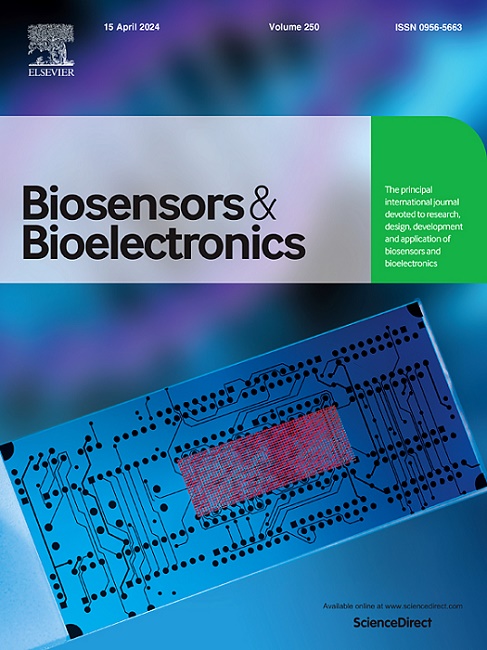Microsampling and exosome-enriched optical biochip for non-invasive detection of breast cancer exosomes in clinical human tear fluid
IF 10.7
1区 生物学
Q1 BIOPHYSICS
引用次数: 0
Abstract
Tumor exosome detection is one of the most clinically relevant liquid biopsy methods for non-invasive breast cancer diagnosis. However, conventional methods are often unsuitable for routine use due to large sample requirements, low precision, and complex procedures. To overcome these challenges, we have developed a novel optical biochip that integrates tear collection, exosome enrichment, and detection into a single platform. This biochip requires only 14 μL of tears and employs dual biomarker aptamers for the simultaneous identification and capture of target exosomes, forming sandwich-like complexes. Subsequently, the chip enriches these sandwich complexes through acoustic radiation, enabling separation from interferences and signal amplification. As a result, the biochip exhibits excellent specificity and ultra-high sensitivity for breast cancer cell exosomes, with a detection limit as low as 1.2 × 102±0.16 × 102 particles/mL and a detection time of approximately 10.42 min. In addition, this optical biochip was used for the first time to detect exosomes related to breast cancer in tears, effectively distinguishing breast cancer patients from healthy donors with 100 % sensitivity and specificity, offering a meaningful approach for on - site breast cancer diagnosis and personalized medical health.
显微取样和外泌体富集光学生物芯片用于临床人泪液中乳腺癌外泌体的无创检测
肿瘤外泌体检测是临床上最有意义的非侵袭性乳腺癌液体活检方法之一。然而,由于样本量大、精度低、程序复杂,传统方法往往不适合常规使用。为了克服这些挑战,我们开发了一种新型光学生物芯片,将泪液收集、外泌体富集和检测集成到一个平台上。该生物芯片只需要14 μL的眼泪,并采用双生物标记适配体同时识别和捕获目标外体,形成三明治状复合物。随后,芯片通过声辐射丰富这些夹层复合体,实现与干扰的分离和信号放大。结果表明,该生物芯片对乳腺癌细胞外泌体具有优异的特异性和超高的灵敏度,检测限低至1.2 × 102±0.16 × 102颗粒/mL,检测时间约为10.42 min。此外,该光学生物芯片首次用于泪液中乳腺癌相关外泌体的检测,以100%的灵敏度和特异性有效区分了乳腺癌患者和健康供体。为乳腺癌的现场诊断和个性化医疗保健提供了有意义的途径。
本文章由计算机程序翻译,如有差异,请以英文原文为准。
求助全文
约1分钟内获得全文
求助全文
来源期刊

Biosensors and Bioelectronics
工程技术-电化学
CiteScore
20.80
自引率
7.10%
发文量
1006
审稿时长
29 days
期刊介绍:
Biosensors & Bioelectronics, along with its open access companion journal Biosensors & Bioelectronics: X, is the leading international publication in the field of biosensors and bioelectronics. It covers research, design, development, and application of biosensors, which are analytical devices incorporating biological materials with physicochemical transducers. These devices, including sensors, DNA chips, electronic noses, and lab-on-a-chip, produce digital signals proportional to specific analytes. Examples include immunosensors and enzyme-based biosensors, applied in various fields such as medicine, environmental monitoring, and food industry. The journal also focuses on molecular and supramolecular structures for enhancing device performance.
 求助内容:
求助内容: 应助结果提醒方式:
应助结果提醒方式:


